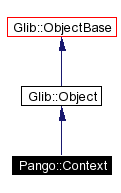
 |
Pango::Context Class Reference
A Pango::Context stores global information used to control the itemization process. More...Inheritance diagram for Pango::Context:

Public Methods | |
| virtual | ~Context () |
| PangoContext* | gobj () |
| const PangoContext* | gobj () const |
| PangoContext* | gobj_copy () |
| Glib::ArrayHandle< Glib::RefPtr< FontFamily > > | list_families () const |
| List all available font families for a context. | |
| Glib::RefPtr<Font> | load_font (const FontDescription& desc) const |
| Loads the font in one of the fontmaps in the context that is the closest match for desc . | |
| Glib::RefPtr<Fontset> | load_fontset (const FontDescription& desc, const Language& language) const |
| Load a set of fonts in the context that can be used to render a font matching desc . | |
| FontMetrics | get_metrics (const FontDescription& desc) const |
| Get overall metric information for a particular font description. | |
| FontMetrics | get_metrics (const FontDescription& desc, const Language& language) const |
| Get overall metric information for a font particular font description. | |
| void | set_font_description (const FontDescription& desc) |
| Set the default font description for the context. | |
| FontDescription | get_font_description () const |
| Retrieve the default font description for the context. | |
| Language | get_language () const |
| Retrieves the global language tag for the context. | |
| void | set_language (const Language& language) |
| Sets the global language tag for the context. | |
| void | set_base_dir (Direction direction) |
| Sets the base direction for the context. | |
| Direction | get_base_dir () const |
| Retrieves the base direction for the context. | |
| ListHandle_Item | itemize (const Glib::ustring& text, const AttrList& attrs) const |
| Breaks a piece of text into segments with consistent directional level and shaping engine. | |
| ListHandle_Item | itemize (const Glib::ustring& text, int start_index, int length, const AttrList& attrs, AttrIter& cached_iter) const |
| Breaks a piece of text into segments with consistent directional level and shaping engine. | |
Protected Methods | |
| Context () | |
Related Functions | |
| (Note that these are not member functions.) | |
| Glib::RefPtr<Pango::Context> | wrap (PangoContext* object, bool take_copy=false) |
Detailed Description
A Pango::Context stores global information used to control the itemization process.You can retrieve a Pango::Context object with Gtk::Widget::create_pango_context() or Gtk::Widget::get_pango_context(). If you don't use gtkmm call some c function of the pango backend you intend to use and create a wrapper for the returned context, e.g. Glib::wrap(pango_x_get_context()).
Creating a Pango::Context object is the starting point of every rendering process. You can either use it to create a high level Pango::Layout object which does all the hard work for you by passing it into Pango::Layout::create() or to generate glyph strings from character strings with the help of itemize() and Pango::Item::shape() subsequently.
Which fonts are used for rendering can be influenced by setting the default font description, language and base direction of the context.
If you want to calculate the space some text will need to be displayed you might find the functions of Pango::FontMetrics useful. Use get_metrics() to obtain the Pango::FontMetrics object for a specific Pango::FontDescription. For more detailed calculations in a rendering-system-independant manner and to determine whether specific characters can be represented by the font that would be used for a specific Pango::FontDescription load a Pango::Fontset with load_fontset() (load_font() returns the Pango::Font that is the closest match for a Pango::FontDescription; however that's not necessarily the font that will be used for rendering).
Constructor & Destructor Documentation
|
|
|
|
|
|
Member Function Documentation
|
|
Retrieves the base direction for the context.
|
|
|
Retrieve the default font description for the context.
|
|
|
Retrieves the global language tag for the context.
|
|
||||||||||||
|
Get overall metric information for a font particular font description. Since the metrics may be substantially different for different scripts, a language tag can be provided to indicate that the metrics should be retrieved that correspond to the script(s) used by that language. The Pango::FontDescription is interpreted in the same way as by pango_itemize(), and the family name may be a comma separated list of figures. If characters from multiple of these families would be used to render the string, then the returned fonts would be a composite of the metrics for the fonts loaded for the individual families.
|
|
|
Get overall metric information for a particular font description. The metrics may be substantially different for different scripts. However this function overload returns the metrics of the entire font.
|
|
|
Reimplemented from Glib::ObjectBase. |
|
|
Reimplemented from Glib::ObjectBase. |
|
|
|
|
||||||||||||||||||||||||
|
Breaks a piece of text into segments with consistent directional level and shaping engine. Each byte of text will be contained in exactly one of the items in the returned list. The generated list of items will be in logical order (the start offsets of the items are ascending). cached_iter should be an iterator over attrs currently positioned at a range before or containing start_index. cached_iter will be advanced to the range covering the position just after start_index + length. (i.e. if itemizing in a loop, just keep passing in the same cached_iter).
|
|
||||||||||||
|
Breaks a piece of text into segments with consistent directional level and shaping engine. Each byte of text will be contained in exactly one of the items in the returned list. The generated list of items will be in logical order (the start offsets of the items are ascending).
|
|
|
List all available font families for a context. You can specify one of these as your desired font family in the Pango::FontDesciption objects you use, e.g. in the default font description of the context.
|
|
|
Loads the font in one of the fontmaps in the context that is the closest match for desc .
|
|
||||||||||||
|
Load a set of fonts in the context that can be used to render a font matching desc .
|
|
|
Sets the base direction for the context.
|
|
|
Set the default font description for the context.
|
|
|
Sets the global language tag for the context.
|
Friends And Related Function Documentation
|
||||||||||||
|
|
The documentation for this class was generated from the following file:
Generated for gtkmm by Doxygen 1.3-rc1 © 1997-2001